
Austrian cavalry, from the collection of Paul Armont (www.flats-zinnfiguren.com)
From left to right: chevauleger, hussar, uhlan, cuirassier and dragoon.
|
The Austrian Cavalry.
Exploits of Austrian cavalry during the Napoleonic wars:
French Carabiniers and Cuirassiers vs Austrian Cuirassiers and Hussars |

Tactics of Austrian Cavalry John Elting wrote: "Austrian cavalry was well mounted and generally good but seldom operated effectively in mass. It seems that with the exception of Liechtenstein and Nostitz the French generals better operated the multiregimental formations. Only in few cases the Austrians used such multiregimental formations. For example in 1809 at Aspern-Essling General Liechtenstein sent nine cavalry regiments against French light cavalry under Lasalle. Four regiments attacked from the front and five attacked Lasalle's flank. The Austrians drove off the French.
There was lack of precise instructions for multi-regiment formations and large scale exercises. The consequences of this practice of scattering their cavalry in small bodies were very serious. It greatly reduced the combat effectiveness, often single regiments and brigades were defeated by French brigades and divisions. |

Organization and Strength of Austrian Cavalry
In March 1809 were:
In 1812-1813 the cuirassier and dragoon regiment had 4 sq. of 144 men each, while the chevaulegere, uhlan and hussar regiment consisted of 6 sq. of 180 men each
Organization of cavalry regiment:
. . . . . . . .
Organization of squadron in 1806-1815 (according to Bernhard Woykowitsch):
Hussar squadron of 4 Zuge (Troops)
R hhhhhhhhhh k . .
U hhhhhhhhhh U . .
k hhhhhhhhhh k . .
O hhhhhhhhhh O |

Horses.
The Hungarian horse Lipizzaner (ext.link) was used by the Austrian cavalry. It came from Yugoslav town Lipice. This horse was bigger than Arabian and was well known in the Austrian army. The horse enjoyed a great reputation and even Napoleon obtained one Lipizzaner for himself. The French troops plundered much of the brood-stock from Lipizza and Piber.
The horse was branded with Imperial cipher and a number. The cleaning and feeding of horse was often emphasized, in rain the tail was tied up or bound to half of its length. All horse harness was brown in every cavalry regiment. The lambskin on saddle was either white or black, and the big shabraques were red.
The minimum height of horses in Austrian cavalry:
This is what Dave Hollins had to say about horses for the hussars; "The Hussars preferred Hungarian and Transylvanian horses or Polish ponies between 4 and 7 years old, standing 14-15 hands ... usually colored wholly dark bay, brown or black, although each squadron tried to maintain as little variation in color as possible... Each officer on the buying party would carry a horse measure ('Hippometer'), more than 18 Faust' high and a finger-thickness in width."
|

Weapons.
Firearms of cavalry: The big cuirassier carried 2 pistols and straight broadsword. The British heavy cavalry sword was entirely modeled on this weapon. The Austrian cuirassier was protected with amor (front-plate only). Each squadron of cuirassiers had 8 men armed with rifles and 8 with carbines. (Before the helmets were introduced the cuirassiers wore protective iron crosses inside their tricorn hats.) The dragoon was armed with carbine and straight and heavy pallash. Each squadron of dragoons had 16 men armed with rifles. The uhlan carried 2 pistols, curved saber and a lance. Each squadron of uhlans had 8 men armed with rifles and 8 with carbines. In uhlan regiment of 4 divisions, the central 2 divisions were armed with lances, the 2 flank divisions with carbines. The chevauleger (lighthorseman) carried a carbine and saber (until 1802 heavy pallash). From 1804 all caried the longer carbines. Each squadron of chevaulegers had 16 men armed with rifles.
The hussar carried 1803-pattern saber (84 cm long blade), with iron scabbard. The hussar carbine was 1798-pattern weapon, 85 cm long and weighing 2.45 kg with disproportionately large butt. The short ramrod was carried on the cartridge box crossbelt and was also used for the pistol. The 1815-pattern hussar carbine had an even shorter barrel (75.7 cm).
Six sharpshooters per squadron were designated to be issued with rifles. The rifle was heavy (4.4 kg) and was replaced by the shorter 1789-pattern modelled on a Prussian design.
|
|

Nationalities. The Austrian army was multi-national, one could find not only Austrians but also Swedes, Englishmen, Scots, Irishmen, Poles, Russians, Ukrainians, Prussians, Croats, Serbs, and even French royalists. The Bussy Horse Jagers were made of French royalists (emigres) in Austrian service. Ironically this unit participated in the defeat of Bonaparte's grenadiers of Consular Guard at Marengo, 1800.
The hussars were almost all Hungarians (the 11th was made of Transylvanians). |
|

Chevaulegeres
Chevau legere means light horse. For many wargamers in English-speaking countries the chevaulegeres are the most popular
of Austrian cavalry. Many military men had a very high opinion about them.
Chlapowski of Napoleon's Lancers of Old Guard writes: "... was of the opinion then, as I am still today, that
the Austrian light horse is the best trained in this kind of warfare [skirmish]. The Austrians are always the most skilled at placing outposts to guard their army."
(Chlapowski/Simmons - "Memoirs of a Polish Lancer" p 15)
In 1788 Austria had 6 regiments of chevaulegeres, in 1791 were 7. In 1798 the seven chevauleger regiments were renamed to light dragoons but few months later they became dragoons. In 1801-1802, five light dragoon regiments and a newly formed dragoon regiment became chevaulegeres. In 1814 seventh regiment of chevaulegeres was formed of Italians.
|

The Hungarian Hussars !
The Hungarian hussars serving in the Austrian army had reputation of being excellent horsemen
known for quality of their mounts. They had been familiar figures since XVII Century and had
been imitated by other armies. Although the Hungarian hussars were not big guys
(their height between 165 and 173.5 cm) they were known for dash in combat. They became
so known in Europe that their outfit became popular across Europe, including France, Russia,
England and Spain.
The outposts, patrols and pickets were a key role for the light cavalry during war. Any Hungarian hussar found asleep or drunk on such duty was subject to execution. The hussars raided the countryside and even towns were no problem for these dare-devils ! "... during Bonaparte's advance across Italy in 1796, 30 men from the 8th Hussars launched a surprised raid on the French-held city of Brescia on 30 June and quickly chased the guards from the walls. The gates were opened and the rest of the squadron swept in, reaching the town drill square, where the garrison troops were scattered and many taken prisoner. The 1st Hussars adopted a typically resorceful approach when facing the barricaded gates of Bamberg in August 1796. Ordered by the senior command to break it, they simply ripped the hinges from the wall and the gates fell in." (Hollins - "Hungarian Hussar 1756-1815" p 26)
Recruitment
The Bravest of the Brave
The colonel of 4th Hussar Regiment, Josef Simony Vitézvár, was called as the bravest hussar of all times.
On 14-15th September 1813 at Lipa (Lippa) the Austrian infantry began a gradual withdrawal
to a second position. During the withdrawal, the Italian cavalry (French allies)
took advantage of this situation and launched an attack. However, half squadron of the
Austrian Radetzky hussars pushed through the intervals in the withdrawing Austrian infantry
and drove back six squadrons of the Italian cavalry (chasseurs-a-cheval) under
General Perreimond. Incredible, one vs six squadrons.
(Nafziger and Gioannini - "The Defense of the Napoleonic Kingdom of Northern Italy 1813-1814"
pp 52 and 265)
|

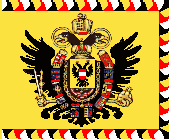
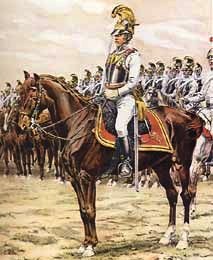 The Austrian cavalry consisted of cuirassiers, dragoons, chevaulegeres (light dragoons), hussars and uhlans. They were excellent swordsman and horsemen, well-trained and well-mounted and enjoyed great reputation in Europe. For French cavalry officer, de Brack, the Hungarian hussars were some of "the best European cavalry." Sir Wilson wrote about the Austrian cavalry: "... both cuirassiers and hussars are superb". Anoher British observer described their cuirassiers in 1814 in Paris as "outstanding".
According to "The Armies of Europe": "The [Austrian] cavalry is excellent.
The heavy or "German" cavalry, consisting of Germans and Bohemians is well horsed, well armed, and always efficient. The light cavalry has, perhaps, lost by mixing up the German chevau-légers with the Polish lancers, but its Hungarian hussars will always remain the models of all light cavalry." ("The Armies of Europe" in Putnam's Monthly, No. XXXII, published in 1855)
The Austrian cavalry consisted of cuirassiers, dragoons, chevaulegeres (light dragoons), hussars and uhlans. They were excellent swordsman and horsemen, well-trained and well-mounted and enjoyed great reputation in Europe. For French cavalry officer, de Brack, the Hungarian hussars were some of "the best European cavalry." Sir Wilson wrote about the Austrian cavalry: "... both cuirassiers and hussars are superb". Anoher British observer described their cuirassiers in 1814 in Paris as "outstanding".
According to "The Armies of Europe": "The [Austrian] cavalry is excellent.
The heavy or "German" cavalry, consisting of Germans and Bohemians is well horsed, well armed, and always efficient. The light cavalry has, perhaps, lost by mixing up the German chevau-légers with the Polish lancers, but its Hungarian hussars will always remain the models of all light cavalry." ("The Armies of Europe" in Putnam's Monthly, No. XXXII, published in 1855)
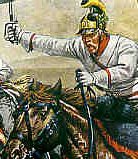 The Austrian cavalry regiment consisted of 2-4 divisions, each of 2 squadrons. The division and not the squadron was considered as "the main tactical element."
The Austrian cavalry regiment consisted of 2-4 divisions, each of 2 squadrons. The division and not the squadron was considered as "the main tactical element."
 Horses were acquired from 3 sources:
Horses were acquired from 3 sources: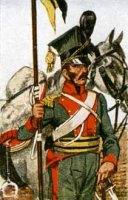 On picture: Austrian Ulanen-Regiment Fürst Schwarzenberg Nr. 2
On picture: Austrian Ulanen-Regiment Fürst Schwarzenberg Nr. 2
 In 1805 at Austerlitz part of French 3rd Dragoon Division (5th, 8th, and 12th Dragoon Regiment)
formed in column was outflanked and routed by a single chevaulegeres regiment.
The second brigade of the 3rd Dragoon Division was defeated in identical way.
But when the 21st Dragoon Regiment (formed in column) charged the chevaulegeres stampeded.
In that year the 21st Dragoon Regiment was an excellent unit, it had 50 % veterans of several campaigns and 10-15 years' service.
In 1805 at Austerlitz part of French 3rd Dragoon Division (5th, 8th, and 12th Dragoon Regiment)
formed in column was outflanked and routed by a single chevaulegeres regiment.
The second brigade of the 3rd Dragoon Division was defeated in identical way.
But when the 21st Dragoon Regiment (formed in column) charged the chevaulegeres stampeded.
In that year the 21st Dragoon Regiment was an excellent unit, it had 50 % veterans of several campaigns and 10-15 years' service.
 The Hungarians were excellent horsemen and serving in infantry was not their first choice. "...
they were convinced that they were unsuitable for dismounted service... All the regulations in the world nevertheless failed to shake the convinction among the Hungarians that to be 'stuck among the infantry' was the worst fate that could befall them." (Duffy - "Instrument of War" Vol I p 237)
The Hungarians were excellent horsemen and serving in infantry was not their first choice. "...
they were convinced that they were unsuitable for dismounted service... All the regulations in the world nevertheless failed to shake the convinction among the Hungarians that to be 'stuck among the infantry' was the worst fate that could befall them." (Duffy - "Instrument of War" Vol I p 237)
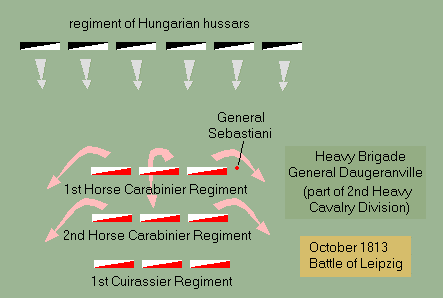 Rilliet from the French 1er Cuirassiers witnessed the encounter between the horse carabiniers and Hungarian hussars at Leipzig: "We were in column of regiments. The 1er Carabiniers were
in front and general Sebastiani was to the right of the regiment: all at once a mass of
enemy cavalry, mainly Hungarian hussars, rode furiously down on the carabiniers. 'Bravo!'
cried the general, laughing and waving the riding crop which was the only weapon that he
designed to use. 'This will be charming; hussars charging the horse carabiniers.' But when the Hungarians were 100 paces away, the 1er Carabiniers turned about
and fled leaving behind their brave general ! They hastily rode back
on to the 2e Carabiniers and both regiments hooved away. It was such a disgrace that
when after battle a group of carabiniers entered a farm seeking quarters, the cuirassiers
from the 5e Regiment teased them: "If you want hospitality, try the Hungarian hussars !" :=)
Rilliet from the French 1er Cuirassiers witnessed the encounter between the horse carabiniers and Hungarian hussars at Leipzig: "We were in column of regiments. The 1er Carabiniers were
in front and general Sebastiani was to the right of the regiment: all at once a mass of
enemy cavalry, mainly Hungarian hussars, rode furiously down on the carabiniers. 'Bravo!'
cried the general, laughing and waving the riding crop which was the only weapon that he
designed to use. 'This will be charming; hussars charging the horse carabiniers.' But when the Hungarians were 100 paces away, the 1er Carabiniers turned about
and fled leaving behind their brave general ! They hastily rode back
on to the 2e Carabiniers and both regiments hooved away. It was such a disgrace that
when after battle a group of carabiniers entered a farm seeking quarters, the cuirassiers
from the 5e Regiment teased them: "If you want hospitality, try the Hungarian hussars !" :=)